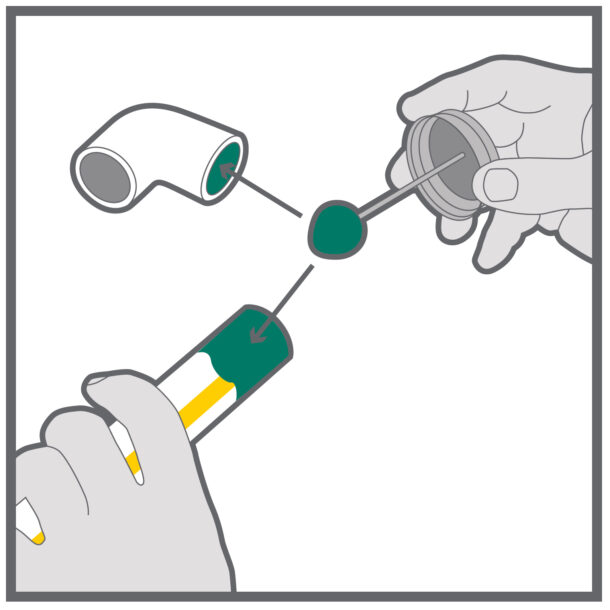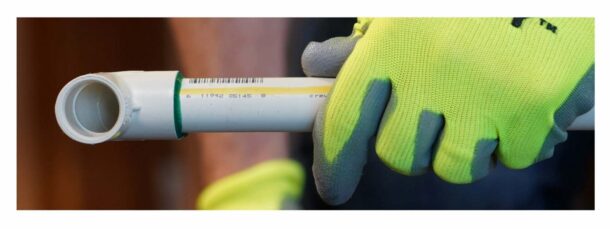By Jonathan Simon
The 2024 plumbing and mechanical codes contain a subtle but significant change all plumbers should know. For the first time, green-colored solvent cement has been approved into the model codes for use with copper-tube size CPVC. Here’s how that change came about and what it means to plumbing contractors.
The Need for Change
Plumbers who work with CPVC appreciate its ease of installation, reliability, and the straight, professional appearance that showcases the plumber’s craftsmanship. But in recent years, plumbers have become increasingly concerned with the risk of dry-fit failures that occur when a joint is not properly solvent welded. The team behind FlowGuard Gold CPVC received feedback from plumbers that the lack of contrast between the yellow cement and the tan pipe could make it difficult to see the solvent cement when visually inspecting installations.
That’s important because CPVC pipes and fittings have an interference fit in which the fitting socket is tapered, so the outer diameter of the pipe is slightly larger than the inside diameter at the bottom of the fitting. When solvent cement is applied and the pipe is bottomed out in the fitting, the two components are fused into a single piece of CPVC and create a joint that is extremely strong and reliable.
But with a tight interference fit, a dry joint can still be strong enough to withstand a pressure test without being solvent welded. Because of this extreme joint strength, even an unwelded CPVC joint can hold for a long time under everyday operating conditions, but eventually natural movement and stress on the system will cause an unwelded joint to fail. These dry-fit installation errors are extremely rare but can be very frustrating.

Eliminating Dry Fit Errors
There are two steps plumbers can take to eliminate dry-fit errors. One is to weld each joint as it is assembled. This helps ensure every joint is solvent welded and has the added benefit of enabling faster, more efficient installation than pre-assembling the entire system and then coming back through with solvent cement.
The other is to visually inspect the system after installation to ensure solvent cement is visible around each joint. Visual inspection is a critical step in any piping installation process, so when contractors told us that visual inspection was more challenging than it could be due to the color of the cement, we began exploring solutions.
Because the plumbing and mechanical codes required that one-step solvent cement be yellow in color, FlowGuard Gold first worked with our solvent cement partners to develop a cement that includes a UV indicator. This allows the contractor or installer to verify solvent welded joints using a UV flashlight. This solution proved effective, but we recognized there was an opportunity to make the process even easier for plumbers.
Changing the Plumbing Code
In 2020, we asked our solvent cement partners to support the manufacture of a new color solvent cement that would provide high contrast when used with FlowGuard Gold pipe and fittings and they agreed. By listening to the voice of plumbing and mechanical contractors across the country, we identified the color green as the ideal solution for a high contrast CPVC solvent cement.
The next step was to get code approval for the green-colored cement. We developed and presented a proposal to the leading code organizations requesting that the green-colored cement be approved as an alternative to yellow for copper-tube size CPVC. Because the color change did not impact the installation process or the performance of the cement, the proposal met no resistance in technical committees or in the public comment stage of the process.
The proposals were approved in 2023 and high-contrast green solvent cement is now included in the 2024 International Plumbing Code, section 605.14.2; the International Mechanical Code, section 1203.3.4; the Uniform Plumbing Code, section 605.2.2; and the Uniform Mechanical Code, section 1211.3.2.

A Welcome Addition
Because our solvent cement partners were involved in the process from the beginning, they were prepared to bring green-colored, one-step solvent cement to market as soon as the proposed changes were underway. Simultaneously, the team communicated with state, county and local code officials across the U.S. informing them of the pending change and the reason behind it so they could feel confident approving installations using the high-contrast cement in the period between when the changes were approved and published.
These steps allowed contractors, with approval from the appropriate official, to begin using the green-colored cement as early as 2021. Feedback from early adopters was uniformly positive. A number of contractors transitioned to high-contrast green solvent cement for all their projects before the new codes were even published and use of the green-colored solvent cement continues to build momentum in the market.
Even though green-colored cement is now included in the published 2024 codes, it is recommended that contractors verify local codes and approvals prior to installation and always follow the manufacturer approved instructions.
A Small Addition with Big Benefits
Plumbing contractors working with CPVC now have three choices in manufacturer-authorized and code-approved FlowGuard solvent cement: traditional yellow, yellow with UV indicators, and high-contrast green. While the addition of green-colored cement represents a small addition to the FlowGuard Gold CPVC product family, it is a significant advancement giving contractors working with CPVC greater peace of mind and improved jobsite quality control. For more information on FlowGuard Gold CPVC, visit FlowGuardGold.com.
 Jonathan Simon is the North American residential plumbing manager for Lubrizol Advanced Materials Inc., the parent company for FlowGuard Gold Pipe and Fittings.
Jonathan Simon is the North American residential plumbing manager for Lubrizol Advanced Materials Inc., the parent company for FlowGuard Gold Pipe and Fittings.




Join the conversation: